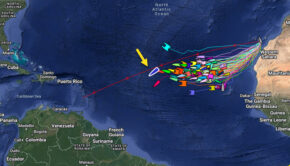Why did Bayesian sink?
Published on August 23rd, 2024
G. Bruce Knecht is a former staff writer for The Wall Street Journal and the author of The Proving Ground: The Inside Story of the 1998 Sydney to Hobart Race and Grand Ambition: The Extraordinary Yacht, the People Who Built It, and the Millionaire Who Can’t Really Afford It. In this report originally published in Barron’s, he reviews the latest tragedy in sailing:
Why did it sink?
Bayesian was a massive sailing yacht with one of the tallest masts in yachting history, a 246-foot pole that would have commanded attention even if it hadn’t been illuminated at a peaceful anchorage just north of Sicily on Sunday night.
Mike Lynch, the owner, a British tech billionaire who had been compared to both Bill Gates and Steve Jobs, was onboard, celebrating his acquittal on fraud charges that could have sent him to prison for 20 years. He was joined by members of his family, two of the lawyers who defended him, and an investment banker who had provided helpful testimony.
It would be difficult to imagine a better platform for celebrating, a luxuriously appointed $30 million floating palace capable of transporting guests from one Mediterranean paradise to another, looked after by an attentive crew and a talented chef.
But early on Monday morning, it all took a turn. Unpleasant weather had been expected, but it suddenly became much worse than that. Just after 4 a.m., the wind reached hurricane force and, worse, spun up a waterspout, a whirling, tornado-like column of air and water capable of inflicting extraordinary violence.
The 184-foot-long Bayesian, still at anchor, began rocking from side to side. Karsten Borner, the skipper of another vessel nearby, told Reuters that Bayesian soon “went flat,” meaning its mast tipped all the way over until it was in the water and the hull was on its side.
Just a few minutes after that, Bayesian was gone. Fifteen people from the yacht were rescued; seven are dead, including Lynch and Jonathan Bloomer, chair of Morgan Stanley International.
It didn’t take long for the internet to explode with theories. It seemed like everyone who had anything to do with boats had something to say, and parallel discussions ricocheted through the tech and finance worlds.
Some of the theories involved mechanical failures and broken seals. Some were patently false, starting with the suggestion that the mast, hit by lightning, fell and thus caused the boat to lose stability. In truth, the mast could act like a destabilizing pendulum. Other theorists noted that it was a warm night, so passengers left their stateroom windows open, allowing waves to enter the interior, even though the seas were relatively calm throughout the night and modern superyacht interiors are sealed up and air-conditioned.
There was even a movie-worthy conspiracy theory, fueled by an onshore death that occurred just two days before Bayesian’s sinking. Stephen Chamberlain, Lynch’s co-defendant in the fraud case, was jogging in England on Saturday morning when he was struck by a car and died. But the idea that someone had arranged both deaths seems far-fetched. For one thing, the driver of the car remained at the scene and cooperated with police.
There is still no certainty about what did happen to Bayesian—multiple investigations are under way. But the answer almost certainly lies in a combination of extraordinary weather conditions and a trio of design features that set Bayesian apart from most sailing yachts: its extraordinary mast; a “lifting keel” that could be extended or retracted beneath the boat, altering its depth from a minimum of 13 feet to a maximum of 32; and a pair of large cockpits where guests could relax and dine.
Even with Bayesian at anchor with its sails down, the pressure of the wind against that mast and the rigging would have caused the yacht to rock. In acting like a pendulum, the outsize mast exaggerated each rocking. Perhaps the boat was at its most vulnerable angle when a gust stuck to set it on its side. But that alone seems unlikely to be the whole story.
The keel – the underwater structure essential to any yacht’s stability – is sure to command attention in the investigations. Was it extended to its full length or was it retracted? If it was down, it would have counteracted the force of the wind in two ways. First, its resistance against the water would have slowed each of the rocking motions. Much more importantly, a fully extended keel would have substantially counteracted the force of the wind by lowering the yacht’s center of gravity.
Evan Marshall, a London-based superyacht designer who also races aboard large yachts in the Mediterranean, thinks the keel was probably retracted. “The keels on boats like this are rarely extended,” he said. “I know that Bayesian traveled in a straight line on the way to the anchorage, so they were clearly under power, and when you’re under power, you would never have the keel down because it only adds to drag. It slows you down, and you burn more fuel.”
“It’s rare that boats like Bayesian actually sail,” he added. “They’re really motor yachts with sails that occasionally go up. The only time they sail is if the wind is from a direction that will get you to St. Tropez or wherever you’re planning to go.
“If the wind is not in a favorable direction, you’re just going to motor. So, the only time you have the keel down is when you’re actually sailing and you’re going upwind, so the keel can counteract the wind.”
Marshall said it’s also unlikely that the crew lowered the keel after it anchored, explaining, “They’ve no doubt been in severe weather before, and they probably never could have imagined that any sort of condition could knock down the boat.”
And then there’s the waterspout. In August 2019, when a waterspout swept across a harbor near Auckland, New Zealand, it lifted a 60-foot catamaran out of the water and caused it to literally cartwheel over the water before it blasted a 150-foot single-hull sailboat onto its side. That’s what waterspouts can do. They are essentially no different from the tornadoes that lift trucks off the ground and rip houses from their foundations.
When Bayesian was knocked down, it was particularly vulnerable because of its two large cockpits, places where passengers could sit and enjoy meals. One of them, a large sunken seating area, was situated around the mast and opened to the grand saloon, the yacht’s living room, by means of a pair of sliding doors.
“When the boat became unstable, everyone on the crew and some of the guests came on deck, so the companionway entrance to the large cockpit may have been open,” said Marshall, who has reviewed Bayesian’s design. “It’s a large opening, probably six feet across, with a sliding door. Even if the doors were shut, the pressure of the water could have smashed the glass. Regardless, as soon as the boat was knocked down, the cockpit filled really quickly and flooded the boat really quickly.”
It’s only too easy to imagine what came next.
UPDATE: Divers retrieved the last missing body on August 23 and a press conference on August 24 revealed the known facts.









 We’ll keep your information safe.
We’ll keep your information safe.